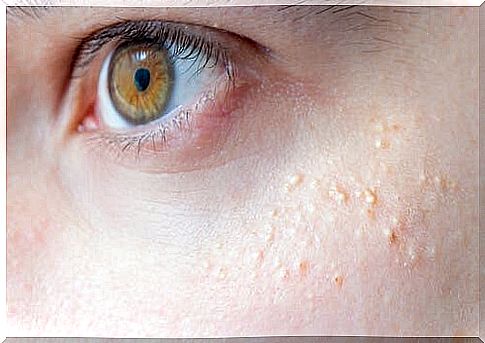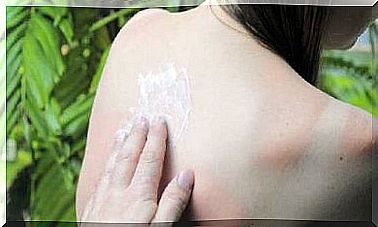Treating Keratosis Pilare With Natural Remedies?

To treat keratosis pilare, dermatologists may suggest the use of products with exfoliating properties, moisturizers and topical retinoids, such as tretinoin and tazarotene. These promote cell renewal and help reduce the obstruction of the hair follicles.
However, as reported by the American Academy of Dermatology, this skin condition is harmless and, in most cases, does not require any specific treatment.
In case of discomfort such as itching, dryness or bad appearance of the skin, you can take some simple precautions. Some natural remedies may also be helpful.
Regarding the latter, it should be remembered that they do not represent a first-line treatment and that there is a lack of elements that prove their effectiveness. Despite this, they are not dangerous and their application can be useful to temporarily calm the discomfort. Would you like to know?
What is keratosis pilare?
Keratosis pilare is a common and benign dermatological disease that causes small, wrinkled bumps to appear on the skin. Because of its appearance, there are those who call it “chicken skin”. Likewise, there are those who tend to confuse it with pimples or acne.
The areas most affected are the arms, thighs, cheeks and buttocks. However, beyond the aesthetic aspect, it generally does not cause discomfort, pain or itching. During the winter, the skin tends to be drier and rougher, causing some discomfort.
The exact causes of this disorder have not yet been identified, but we know that it occurs as a result of an accumulation of keratin, a protein that protects the skin from harmful and infectious agents. The keratin forms small plugs that occlude the hair follicles, thus causing skin irregularities.
Children, adolescents, those with dry skin and overweight people are more prone to suffer from this problem. Nonetheless, in most cases it will improve over the years and therefore no treatment is required.
Is it possible to treat keratosis pilare?
As the Mayo Clinic reports, there are medicines that help improve the appearance of the skin. So, if the bumps and dryness persist despite basic care, your doctor or dermatologist may suggest the use of medicinal creams.
These medicines can be based on urea, lactic acid, retinoids or salicylic acid. In addition, the treatment can be integrated with some natural remedies that appear to improve the skin’s appearance. In the following lines we see these options in detail.

Natural remedies to treat keratosis pilare
There is no remedy that can cure keratosis pilare. Regardless of the use of pharmacological products, the papules can disappear and reappear for many years. Over time, however, this disease improves on its own and tends to become less visible.
It is possible, however, that some remedies of natural origin can be useful in reducing the symptoms of this condition. Most, however, come from popular tradition and lack scientific evidence. In any case, if you decide to try them, you will not take any risks because in most cases they are harmless. Let’s see some possibilities.
Lukewarm baths
According to a Cleveland Clinic publication, many keratosis pilar patients improve their condition by changing their skin care routines. For this purpose, it is useful to resort to baths of lukewarm water, which last no more than 15 minutes (the ideal is that they are shorter).
The use of hot and prolonged showers is not recommended, because they can alter the production of the skin’s natural oils and increase dryness. In addition, it is good to use neutral and moisturizing soaps, especially when the skin tends to be too dry.

Gently exfoliate
Learning to exfoliate carefully will help you remove dead skin cells that stay on the skin’s surface. Thanks to this operation, the appearance of the skin improves considerably. The American Academy of Dermatology recommends using a loofah or a rough towel to perform this treatment.
However, it is important to scrub gently, using circular motions, as doing it forcefully could burst clogged hair follicles and make the situation worse.
When finished, it is recommended to dry by giving small strokes with the towel and apply a moisturizer.
Coconut oil
There is not enough evidence to prove coconut oil’s effectiveness in improving the symptoms of keratosis pilare. Nevertheless, this substance has been used as an adjuvant since it has a moisturizing effect and reduces dryness. Plus, you can combine it with some raw sugar to make a homemade exfoliant.
A review of studies published in the International Journal of Molecular Sciences highlights that coconut oil is an anti-inflammatory and contributes to the regeneration of the skin barrier. It also has an antioxidant effect and protects the dermis from the negative effects of sunlight.
Colloidal oats

Using colloidal oats as part of your keratosis and other skin diseases routine helps keep the dermis hydrated and protected. These are finely chopped oats, which can be added to creams, baths, and other skin care products.
According to a study published in the Journal of Drugs in Dermatology , it is a natural product with anti-inflammatory and antihistamine properties.
It contributes to the improvement of symptoms of atopic dermatitis, psoriasis, drug-induced rashes and other skin diseases.
What else can be done to treat keratosis pilare?
As we have seen, some remedies of natural origin can prove useful to improve the conditions of those suffering from keratosis pilare.
In addition to these substances, it is good to use medicinal products, avoid wearing clothes that are too tight and install a humidifier at home. The latter is used to add humidity to the air present in the home, thus reducing attacks of itching.
Of course, it is important to consult with the dermatologist, especially if the attacks worsen or if you notice any irregularity in their manifestations. The professional may suggest some tests that can determine if the symptoms are due to another problem or direct you to a specific treatment.









